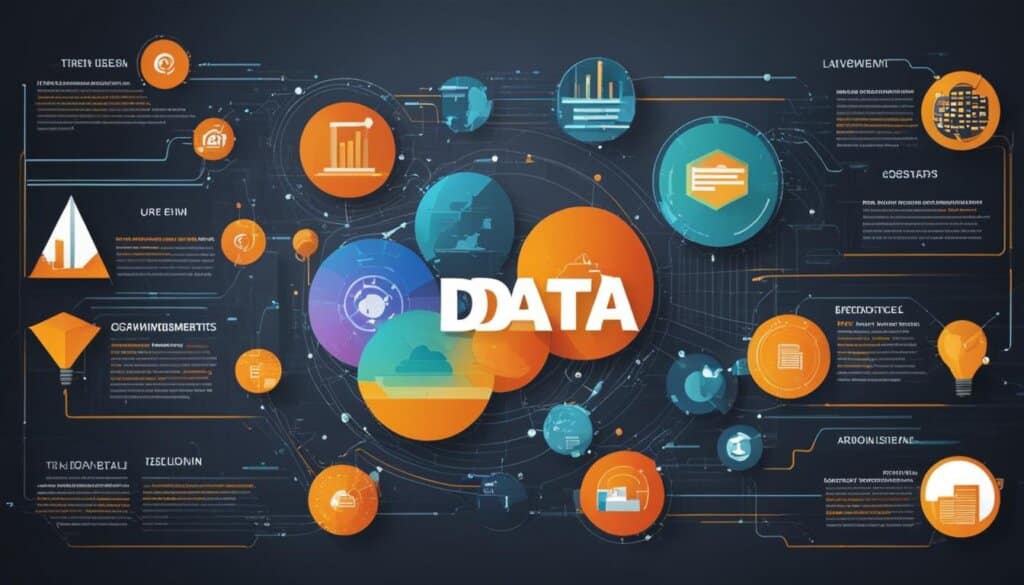Table of Contents
Big data is a term that you may have encountered frequently in today’s digital age. But what exactly is big data? In simple terms, big data refers to data sets that are so large and complex that they cannot be effectively managed and processed using traditional data processing software.
Big data is characterized by the three Vs: volume, velocity, and variety. Let’s break it down:
Volume: Big data involves massive volumes of data. We’re not talking about just a few gigabytes here. We’re talking about data sets that can range from terabytes to petabytes in size. The sheer volume of data is mind-boggling.
Velocity: Big data is generated and received at an astounding speed. It’s not like the data that trickles in slowly. Big data comes at you in real-time, and it’s important to be able to process and make sense of it quickly.
Variety: Another key aspect of big data is the variety of data that it encompasses. In addition to structured data that fits neatly into traditional databases, big data also includes unstructured and semi-structured data such as text, audio, video, and social media data. This variety adds another layer of complexity to the analysis process.
So, in a nutshell, big data refers to the vast and diverse data sets that require specialized tools and technologies to be effectively managed and analyzed. It holds immense potential for businesses to gain valuable insights and make data-driven decisions.
Now that we have a basic understanding of what big data is, let’s take a closer look at the three Vs and explore how they shape the world of big data.
The Three Vs of Big Data
Big data is characterized by three essential factors – volume, velocity, and variety. Let’s dive deeper into each of these aspects:
Volume
The volume of data refers to the sheer amount of information that is generated and collected. It can range from tens of terabytes to hundreds of petabytes, encompassing massive data sets that traditional data processing software struggles to handle.
Velocity
Velocity represents the speed at which data is generated, received, and acted upon. In the world of big data, information needs to be processed and analyzed in real time to extract meaningful insights and enable swift decision-making.
Variety
The variety of data refers to the diverse types and formats it can take. This includes structured data, such as numbers and data organized in defined patterns, unstructured data, such as text, audio, and video files, and semistructured data, which combines elements of both structured and unstructured data.
In the past, traditional data types were well-suited for storage in relational databases. However, the rise of big data necessitates the handling of new, unstructured data types that require additional preprocessing to extract meaning and support metadata.
“Big data is not about data, it’s about insights.”
The Value of Big Data
Big data holds inherent value, but this value can only be realized when it is discovered and analyzed. Many tech companies derive a significant portion of their capital from the data they analyze. Advancements in technology have made data storage and compute more accessible and cost-effective, enabling businesses to store vast amounts of data and make more accurate and precise business decisions.
To find value in big data, a discovery process is necessary. Insightful analysts, business users, and executives play crucial roles in this process by asking the right questions, recognizing patterns, and predicting behavior. This enables businesses to uncover the truth within the data and leverage it to their advantage.
“Big data is becoming big value.”
One key factor in the value equation is the increasing availability and affordability of data storage and compute resources. This has allowed businesses to store and process vast amounts of data that were previously unimaginable. With more accurate and precise data at their disposal, companies can make informed decisions that drive growth and success.
Benefits of Big Data Analysis
The analysis of big data provides several key benefits for businesses:
- Improved Customer Experience: By analyzing customer data, businesses can gain insights into customer preferences and behavior, allowing them to tailor their products and services to better meet customer needs.
- Predictive Maintenance: Big data analysis can help identify patterns and anomalies in equipment performance, enabling proactive maintenance to prevent costly breakdowns and optimize operational efficiency.
- Fraud Detection and Compliance: Big data analytics can detect fraudulent activities by identifying unusual patterns or anomalies in transaction data, ensuring compliance with regulations and protecting companies from financial losses and reputation damage.
- Machine Learning: Big data provides the necessary volume and diversity of data to train machine learning models, which can automate processes, improve efficiency, and drive innovation.
- Operational Efficiency: By analyzing operational data, businesses can identify inefficiencies and optimize processes to reduce costs, improve productivity, and enhance overall operational efficiency.
- Innovation: Big data analysis can uncover new market trends, customer preferences, and emerging opportunities, enabling businesses to stay ahead of the competition and drive innovation.
https://www.youtube.com/watch?v=hTL5NppaS4w
The Importance of Insightful Analysis
To extract the maximum value from big data, insightful analysis is essential. Skilled analysts, business users, and executives who can ask the right questions and recognize meaningful patterns are crucial in uncovering actionable insights that drive business success. The ability to think critically, apply statistical techniques, and leverage advanced analytics tools is key to transforming data into valuable insights.
Furthermore, accurate and precise analysis enables businesses to make data-driven decisions and deliver better outcomes. By leveraging the truth within big data, organizations can adapt and thrive in today’s rapidly evolving business landscape.
| Big Data Value Drivers | Benefits |
|---|---|
| Improved decision-making | Enables businesses to make more informed and strategic decisions based on accurate and precise data analysis. |
| Enhanced competitive advantage | The ability to uncover unique insights from big data can give businesses a competitive edge and position them as industry leaders. |
| Identifying new revenue streams | By analyzing big data, businesses can identify untapped markets, customer segments, and revenue-generating opportunities. |
| Improved operational efficiency | Optimizing processes and eliminating inefficiencies can lead to cost savings and increased productivity. |
| Enhanced customer experience | Personalizing products, services, and marketing strategies based on customer data can improve customer satisfaction and loyalty. |
The History of Big Data
The concept of big data may seem relatively new, but its origins can be traced back to the 1960s and 1970s. During this era, the development of data centers and the advent of the relational database laid the foundation for handling large volumes of information.
However, it wasn’t until the early 2000s that the true potential of big data started to become apparent. With the rise of platforms like Facebook and YouTube, it became evident just how much data users were generating on a daily basis. This realization sparked the need for new tools and technologies to store and analyze these massive data sets.
“In the age of big data, companies all over the world are realizing that the value of their data is tantamount to their most precious assets.” – Harvard Business Review
One of the most influential developments during this time was the creation of Hadoop, an open-source framework designed for storing and processing big data. Hadoop allowed organizations to leverage distributed computing and parallel processing to handle the ever-increasing volumes of data.
Alongside Hadoop, NoSQL databases gained popularity for their ability to handle unstructured and semi-structured data, such as social media posts or sensor data from the Internet of Things. These databases provided a more flexible and scalable alternative to traditional relational databases.
Since then, the volume of big data has skyrocketed. The proliferation of connected devices and the widespread adoption of machine learning have exponentially increased the amount of data generated. In addition, the growth of cloud computing and the availability of open-source frameworks have further expanded the possibilities of working with big data.
One notable development in recent years is the rise of graph databases, which specialize in storing and querying interconnected data. Graph databases have gained prominence due to their ability to uncover complex relationships and connections within large datasets.

As we continue to generate vast amounts of data, the history of big data serves as a reminder of how far we’ve come. From humble beginnings in the 1960s and 1970s to the present day, big data has revolutionized the way we understand and harness information to drive innovation and make informed decisions.
Big Data Benefits
Big data offers numerous benefits to businesses, providing them with comprehensive answers to their questions and enhancing their decision-making processes. This leads to increased confidence in the data and a more innovative approach to problem-solving. Let’s explore some of the key benefits that big data brings:
1. Improved Customer Experience
By leveraging big data, businesses can gain valuable insights into customer behavior and preferences. This information enables them to better understand their customers, personalize their offerings, and provide a more tailored and satisfying customer experience.
2. Enhancing Product Development
With big data analytics, businesses can analyze market trends, customer feedback, and other relevant data to inform their product development strategies. By understanding customer needs and preferences, companies can create innovative products that meet their customers’ demands effectively.
3. Predictive Maintenance
Big data allows companies to implement predictive maintenance systems that utilize real-time data to anticipate maintenance needs and prevent equipment failures. By identifying potential issues before they occur, businesses can minimize downtime, reduce maintenance costs, and ensure optimal operational efficiency.
4. Fraud and Compliance Detection
Big data analytics is invaluable in detecting and preventing fraudulent activities. By analyzing large volumes of data, companies can identify patterns and anomalies that signify potential fraud or non-compliance. This proactive approach helps safeguard businesses and their customers from financial loss and reputational damage.
5. Machine Learning and Automation
Machine learning algorithms thrive on big data, allowing businesses to train models and automate various processes. This enables companies to streamline their operations, improve efficiency, and make data-driven decisions quickly and accurately.
6. Operational Efficiency
Big data analytics provides valuable insights into operational processes and identifies areas for improvement. By optimizing workflows and identifying bottlenecks, businesses can enhance operational efficiency, reduce costs, and maximize resource utilization.
7. Driving Innovation
Big data serves as a catalyst for innovation by uncovering new insights and opportunities that were previously invisible. By analyzing large and diverse datasets, companies can identify trends, discover new markets, and develop innovative solutions that differentiate them from their competitors.
| Benefits of Big Data | Key Industries |
|---|---|
| Improved Customer Experience | Retail, e-commerce, hospitality |
| Enhancing Product Development | Technology, consumer goods, automotive |
| Predictive Maintenance | Manufacturing, energy, transportation |
| Fraud and Compliance Detection | Financial services, insurance, healthcare |
| Machine Learning and Automation | Technology, logistics, customer service |
| Operational Efficiency | Supply chain, manufacturing, utilities |
| Driving Innovation | Research and development, startups, marketing |
Big data offers significant advantages across various industries, empowering businesses to make better decisions, gain a competitive edge, and drive growth through innovation. By harnessing the power of big data, companies can unlock a world of opportunities and achieve sustained success.
Big Data Challenges
While big data holds a lot of promise, it also presents challenges. Organizations today are faced with the task of effectively storing and managing ever-growing volumes of data. With the rapid expansion of data storage requirements, companies need to adapt to the evolving landscape of data storage technologies.
Another significant challenge in the field of big data is data curation. Data scientists spend a considerable amount of time cleaning and preparing data for analysis. This process involves ensuring that the data is accurate, complete, and relevant. It also includes handling data from various sources, linking and matching them to create comprehensive datasets.
Ensuring data quality is vital, as the reliability of insights and decision-making depends on the accuracy of the data. Data quality issues can arise due to inconsistencies, errors, or discrepancies in the data. Organizations must invest time and resources into implementing data quality assurance measures to minimize the impact of such issues.
Moreover, the ever-evolving nature of big data technology poses a challenge in itself. Technology changes at a rapid pace, with new tools and frameworks regularly introduced. Data scientists and data professionals need to stay updated on the latest advancements and adopt new technologies that enhance data management and analysis.
https://www.youtube.com/watch?v=jg7TcpCfBAg
Despite these challenges, organizations recognize the value of big data and are continuously working towards overcoming these obstacles. By addressing the challenges of data storage, data curation, data quality, and keeping up with technology changes, businesses can leverage the potential of big data to drive innovation, make informed decisions, and achieve success in today’s data-driven world.
How Big Data Works
Big data works through a series of interconnected processes, including data integration, data management, data analysis, visual analysis, and decision-making. The first step is data integration, which involves gathering data from various sources and bringing it together into a single repository. This process ensures that all relevant data is captured and available for analysis.
Once the data is integrated, it needs to be managed and stored appropriately. Advanced data management techniques are required to handle the large volume and variety of big data. This includes establishing a centralized data repository, such as a data lake, and implementing efficient storage solutions that can handle the massive amount of data being generated.
Next, data analysis is performed to gain insights and extract meaningful information from the integrated and managed data. Various analytical methods are applied, such as statistical analysis, data mining, and machine learning, to uncover patterns, trends, and correlations within the data. This analysis allows businesses to understand their data better and make informed decisions based on evidence.
To facilitate understanding and communication of the analyzed data, visual analysis techniques are employed. Data visualization tools and techniques are used to create interactive charts, graphs, and dashboards that present the insights in a clear and visually appealing manner. These visual representations help users comprehend complex data and identify key insights at a glance.
Ultimately, the purpose of all these processes is to support decision-making. By leveraging big data, organizations can make data-driven decisions, backed by quantitative evidence and analyses. This enables them to identify opportunities, mitigate risks, optimize processes, and improve overall business performance.
FAQ
What is big data?
Big data refers to larger, more complex data sets that cannot be managed by traditional data processing software. It contains greater variety, arrives in increasing volumes, and has more velocity. Big data is characterized by the three Vs: volume, velocity, and variety.
What are the three Vs of big data?
The three Vs of big data are volume, velocity, and variety. Volume refers to the amount of data, velocity refers to the speed at which data is received and acted upon, and variety refers to the different types of data including structured, unstructured, and semistructured data.
What is the value of big data?
Big data has intrinsic value, but that value is only realized when it is discovered and analyzed. Technological advancements have made data storage and compute cheaper and more accessible, allowing businesses to store more data and make more accurate and precise business decisions. Finding value in big data involves a discovery process that requires insightful analysts, business users, and executives who can ask the right questions, recognize patterns, and predict behavior.
What is the history of big data?
The concept of big data can be traced back to the 1960s and 1970s with the development of data centers and the relational database. In the early 2000s, platforms like Facebook and YouTube led to the realization of how much data users were generating. This led to the development of open-source frameworks like Hadoop for storing and analyzing big data sets. Since then, the volume of big data has increased with the advent of the Internet of Things and machine learning, and cloud computing has expanded the possibilities of big data.
What are the benefits of big data?
Big data allows businesses to gain more complete answers to their questions by providing more information. This leads to greater confidence in the data and a different approach to problem-solving. Big data benefits include improving the customer experience, enabling predictive maintenance, detecting fraud, training machine learning models, improving operational efficiency, and driving innovation.
What are the challenges of big data?
Big data presents challenges such as effectively storing and managing rapidly growing data volumes, time-consuming data curation tasks for data scientists, ensuring data quality from different sources, and keeping up with the constantly evolving big data technology.
How does big data work?
Big data works by integrating data from various sources, managing and storing it in a data lake or other storage solution, and analyzing it to gain insights. Data integration involves bringing in the data, processing it, and making it available for analysis. Big data analytics involves analyzing the data to gain new clarity and insights, which can be visualized and shared with others, ultimately leading to data-driven decision-making and improved decision-making processes based on evidence presented by big data.













